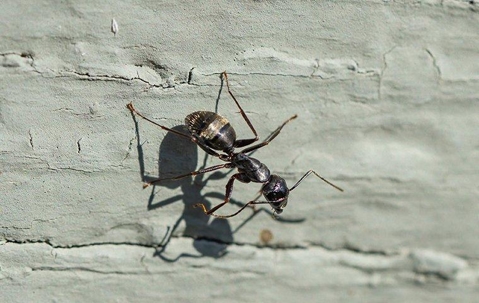Common Local Ants In Turks & Caicos
There are four ant species you’ll find most prevalent on the island: carpenter ants, odorous house ants, pavement ants, and pharaoh ants. Here’s a brief description of them:
- Carpenter ants are large, measuring up to a half-inch in length. As their name suggests, these ants, which are dark brown or black with heart-shaped heads, chew on wood. Though they don’t feed on wood rather, carpenter ants create nests in the cavities they build, which can cause extensive damage to your home.
- Odorous house ants, also known as stink ants and coconut ants, are small, measuring one-sixteenth to one-eighth of an inch. They are dark brown or black with beehive-shaped bodies, and when squashed or in danger, these critters will emit an offensive odor that’s been described as similar to rotten coconut.
- Pavement ants are also small, measuring one-sixteenth to one-eighth of an inch. They are dark brown or black with a shiny exterior and parallel lines on the head and thorax. These ants may transfer bacteria, such as salmonella, to food, food prep areas, and food storage containers, which results from them climbing in the trash and then onto nearby surfaces.
- Pharaoh ants are one of the more difficult species to get rid of, despite their small size. Measuring just one-sixteenth of an inch in length, pharaoh ants range from orange, yellow, and brown in color, with a dark-brown abdomen. Like pavement ants, pharaoh ants can also transfer bacteria and are linked to the spread of salmonella, streptococcus, and other harmful diseases. They’re so difficult to get rid of because they have multiple queens, up to 200 in some colonies, and migrate if disturbed.
Why Is It So Hard To Get Rid Of Ant Infestations?
Ant infestations are difficult to eradicate on your own, and that’s primarily due to their colony sizes and multiple locations. Ant colonies typically include anywhere from 100,000 to 500,000 ants. Yikes! As a result of this high number, surviving colony members can easily move when they suspect disturbance. For this reason, many over-the-counter ant sprays, traps, and pesticides usually won’t rid of the entire infestation. What’s more is that long-term exposure to indoor ant pesticides, such as aerosol sprays or foggers, is toxic for humans and a possible carcinogen.
Three Tips To Prevent Ant Infestations
Although ant infestations can be difficult to prevent, consider these three tips to identify and avert a problem before it grows into an infestation.
- Take action if you see “scout ants”. Scout ants serve as the “scouts” of the colony, and their job is to look for food. If you see rogue ants in your home, especially in your kitchen, it’s a sign that more ants are nearby, and you should take further action.
- Seal up cracks in the foundation and other possible entry points. To prevent ants from entering the home, find and seal all entry points with caulking. Keep an eye on the sealant, as you will need to reapply it over time.
- Only store food in sealed, air-tight containers. Prevent ants from accessing food supply and circumvent the chance of them spreading disease by keeping food out of their reach, including pantry goods.
Contact the professionals at Parkway Pest Solutions of Turks & Caicos if you need additional advice or assistance. We can provide immediate and ongoing support and help keep the pests away - for good. Reach out to us today to learn more about our ant control options! We offer both residential pest control and commercial pest management services.

